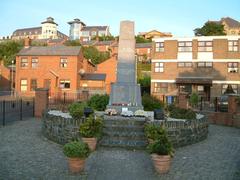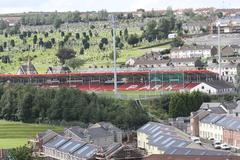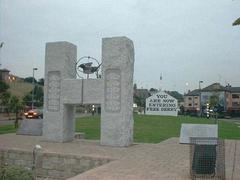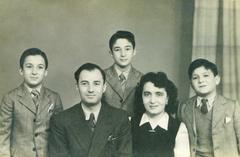
Free Derry Corner: Visiting Hours, Tickets, and Historical Sites in Derry, United Kingdom
Date: 04/07/2025
Introduction
Free Derry Corner, located in the Bogside neighborhood of Derry, Northern Ireland, is one of the most significant civil rights landmarks in Europe. The white gable wall, emblazoned with the phrase “You Are Now Entering Free Derry,” stands as an enduring symbol of resilience, activism, and the turbulent history of the city during the Troubles. This guide offers detailed information for visitors, including historical background, visiting hours, ticketing for nearby attractions, accessibility, guided tours, and tips for a respectful and meaningful experience.
For additional historical insights and up-to-date visitor information, consult the Museum of Free Derry and the Visit Derry tourism website.
Table of Contents
- Historical Background
- The Civil Rights Movement and the Birth of Free Derry
- The No-Go Area Era (1969–1972)
- Bloody Sunday and Legacy
- Operation Motorman and Aftermath
- Free Derry in the Peace Process
- Visitor Information: Hours, Tickets, and Accessibility
- Guided Tours and Special Events
- Nearby Historical Sites
- Practical Tips and FAQs
- Summary and Travel Tips
- References
Historical Background
Derry, also called Londonderry, is one of Ireland’s oldest cities, with a history spanning over 1,400 years. The Bogside area, where Free Derry Corner is located, became predominantly Catholic as a result of historical residential restrictions, exacerbated during and after the Great Famine in the 1840s. This led to a Catholic majority that was politically marginalized after the 1921 partition of Ireland (museumoffreederry.org).
Civil rights activism gained momentum in the 1960s as the Catholic community protested against discrimination in housing, employment, and voting rights (museumoffreederry.org).
The Civil Rights Movement and the Birth of Free Derry
The Northern Ireland civil rights movement found its epicenter in Derry. A pivotal moment occurred on October 5, 1968, when a peaceful protest in Duke Street was violently dispersed by police (museumoffreederry.org).
In January 1969, escalating violence prompted residents to erect barricades, leading to the creation of Free Derry. The iconic slogan was painted on the wall by teenager Liam Hillen, inspired by activist Eamonn McCann and adapted from the Berkeley Free Speech Movement (Irish Times; Guide to Europe). Free Derry became a self-declared autonomous area, a “no-go” zone for police and the British Army (Wikipedia).
The No-Go Area Era (1969–1972)
From January 1969 to July 1972, Free Derry functioned as a self-governing enclave, with local residents organizing defense and community services. Radio Free Derry broadcasted news, and the area became the heart of civil rights activism. This period was marked by confrontations with security forces and internal debates, but the community’s resilience laid the groundwork for ongoing activism (museumoffreederry.org).
Bloody Sunday and Legacy
On January 30, 1972, British soldiers opened fire on a peaceful march in the Bogside, killing 14 unarmed civilians. The events of Bloody Sunday, commemorated at Free Derry Corner and the Museum of Free Derry, deepened mistrust and intensified the Troubles (museumoffreederry.org). The wall became a focal point for remembrance and collective mourning, and its significance as a symbol of resistance was further cemented (Irish Times).
Operation Motorman and Aftermath
Operation Motorman on July 31, 1972, saw the British Army dismantle barricades and reestablish control over the Bogside, ending Free Derry’s status as a no-go area (museumoffreederry.org). However, the area remained highly militarized for years, and the community continued to face hardship.
Free Derry in the Peace Process
Despite decades of conflict, the community’s spirit endured and contributed to the peace process that led to the 1998 Good Friday Agreement. The wall remains a living canvas for local and global causes, from civil rights to public health, and continues to be repainted to reflect contemporary struggles (Guide to Europe; Visit Derry Blog).
Visitor Information: Hours, Tickets, and Accessibility
Visiting Hours
- Free Derry Corner is an outdoor public landmark accessible 24/7, year-round, with no admission fee (Evendo; TripHobo).
- Museum of Free Derry: Open Tuesday–Saturday, 10:00 AM – 5:00 PM (last admission 4:30 PM). Check the museum’s website for holiday closures and current hours.
Tickets
- Free Derry Corner: No tickets required.
- Museum of Free Derry: Admission fee applies (approx. £7 for adults, discounts available). Purchase tickets at the entrance or online.
Accessibility
- Free Derry Corner: Level pavements, wheelchair and stroller accessible.
- Museum of Free Derry: Wheelchair accessible, audio guides, and tactile exhibits for visitors with disabilities.
Guided Tours and Special Events
- Guided walking tours are available from local operators, providing historical context and personal insights (Try Travel; Happy to Wander).
- Annual commemorative events, notably for Bloody Sunday in January, draw crowds and offer unique perspectives (BBC).
- It is recommended to book tours in advance during peak seasons.
Nearby Historical Sites
Enhance your visit by exploring these nearby attractions:
- People’s Gallery Murals: 12 large murals along Rossville Street, depicting moments from the Troubles (Seeing Southern).
- Bloody Sunday Memorial: Directly opposite Free Derry Corner, a site of remembrance for the 14 civilians killed in 1972.
- Guildhall: Neo-Gothic building with exhibitions and stained glass (Wanderers Compass).
- Derry City Walls: 17th-century walls with panoramic city views (The Irish Road Trip).
- Peace Bridge: Modern pedestrian bridge symbolizing citywide reconciliation.
Practical Tips and FAQs
Visiting Tips
- Weather: Derry’s climate is mild but changeable; bring a raincoat and wear comfortable shoes (Wanderlog).
- Best Times: Daylight hours are best for viewing murals and memorials. Allow 1–2 hours for the full experience.
- Restrooms and Food: No facilities at Free Derry Corner; visit the Museum of Free Derry or nearby cafés and pubs for amenities.
- Photography: Permitted and encouraged, but be respectful, especially during events or commemorations.
FAQs
Q: Is Free Derry Corner free to visit?
A: Yes, the site is open 24/7 with no admission fee (Evendo).
Q: Are guided tours available?
A: Yes, guided walking tours are provided by local operators (Seeing Southern).
Q: Is the site accessible?
A: The main site is wheelchair accessible; some surrounding streets may be uneven.
Q: How do I reach Free Derry Corner?
A: It is a 10–15 minute walk from the city center, near public transport stops (TripHobo).
Q: Are there ticketed attractions nearby?
A: The Museum of Free Derry and some other museums charge admission; check official websites for current prices.
Summary and Travel Tips
Free Derry Corner is a powerful symbol of Derry’s struggle for justice and peace. Its accessibility, poignant murals, and central location make it an essential stop for anyone interested in the history of Northern Ireland. Enhance your visit by exploring the Museum of Free Derry, the People’s Gallery, the Guildhall, and the Peace Bridge. For a deeper understanding, consider a guided tour and engage respectfully with the local community.
For the latest updates, download the Audiala app for audio tours, and consult the Museum of Free Derry and Visit Derry for official information.
References and Further Reading
- Museum of Free Derry
- Irish Times: 50 Years On
- Guide to Europe: Free Derry Corner
- Evendo: Free Derry Corner
- Happy to Wander: Things to Do in Derry
- Try Travel: Derry Attractions
- TripHobo: Free Derry Corner
- Wanderers Compass: Exploring Derry
- The Girl Who Goes: Derry Guide
- Seeing Southern: Entering Free Derry
- BBC News: Bloody Sunday Commemoration
- Wanderlog: Best Free Attractions in Derry
- The Irish Road Trip: What to Do in Derry
All hyperlinks direct to referenced sources for further reading and verification.










